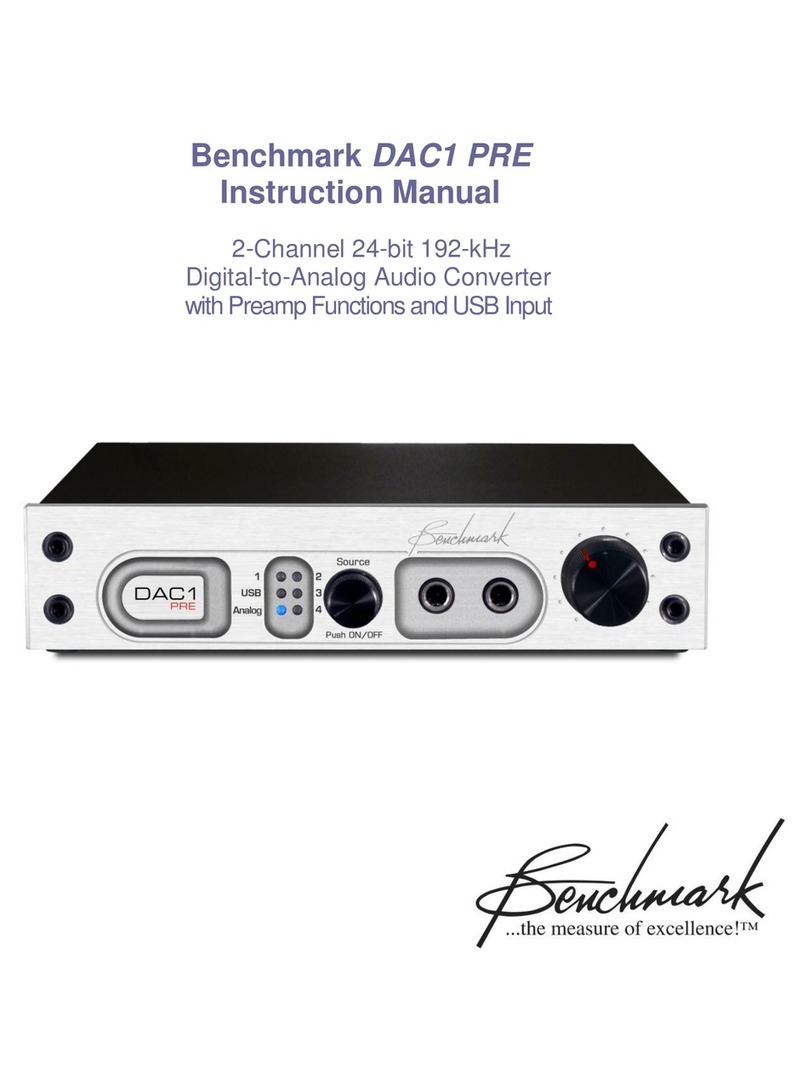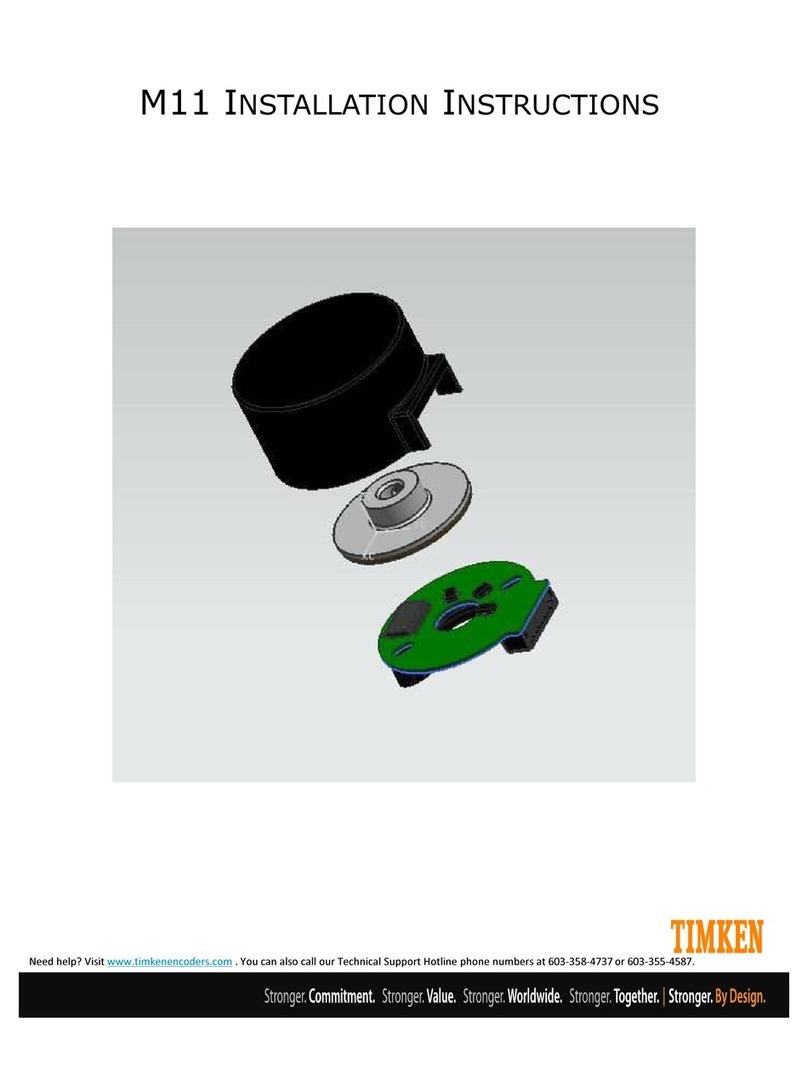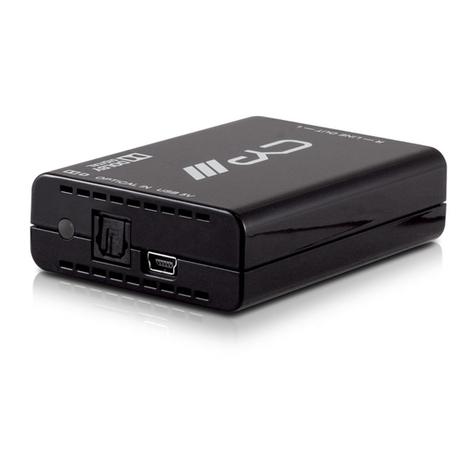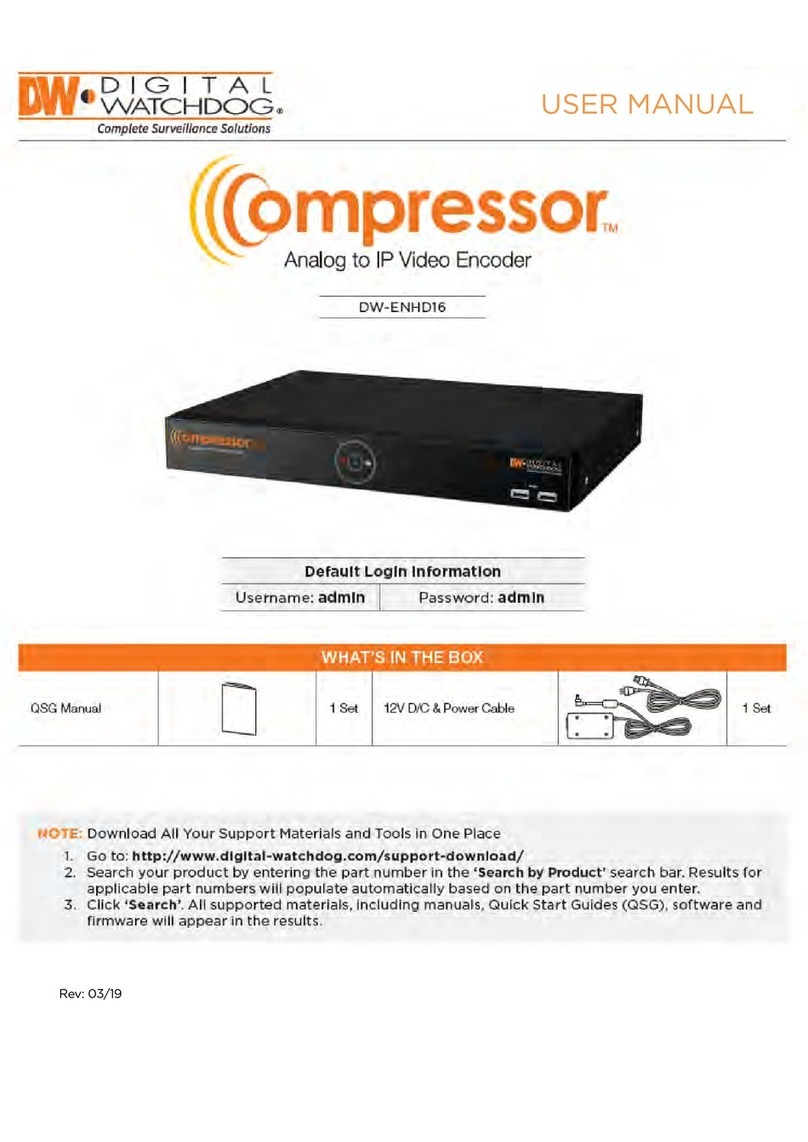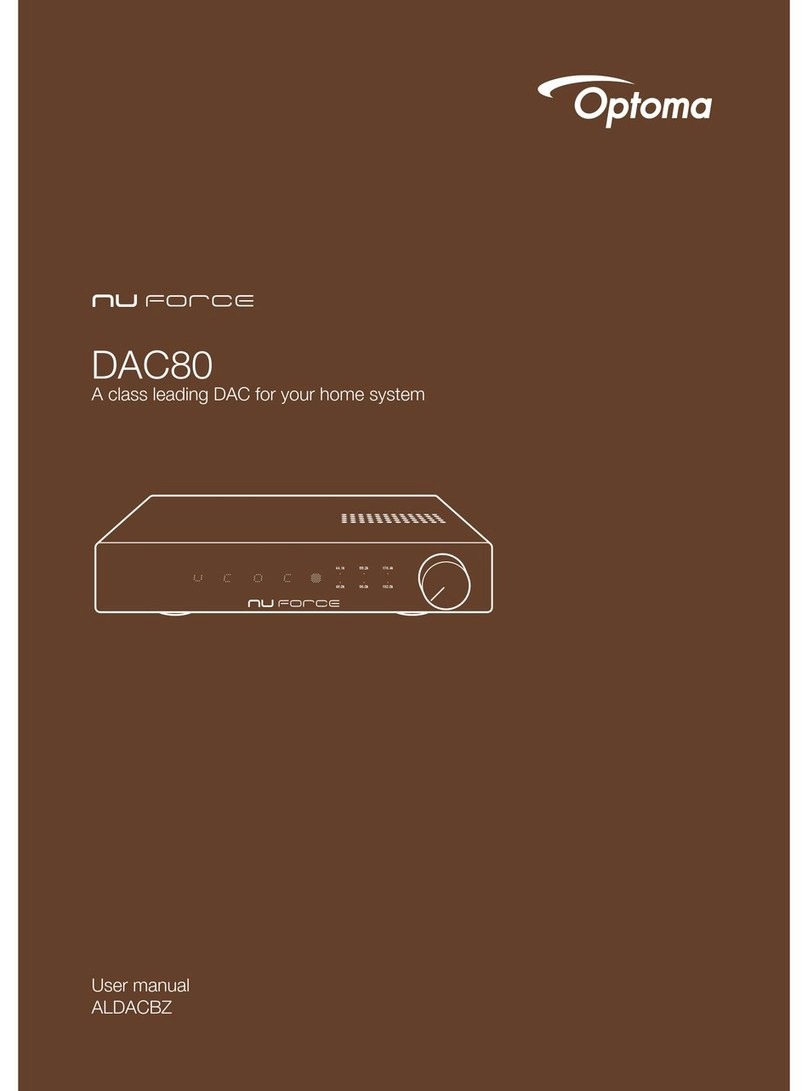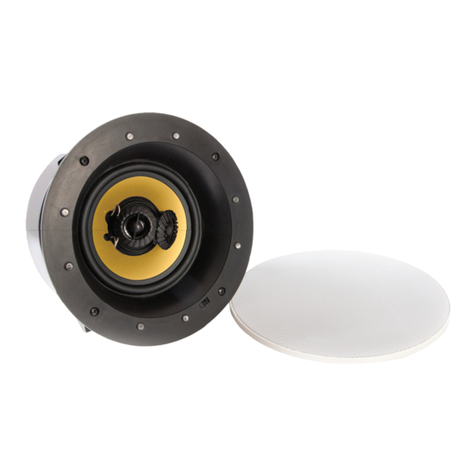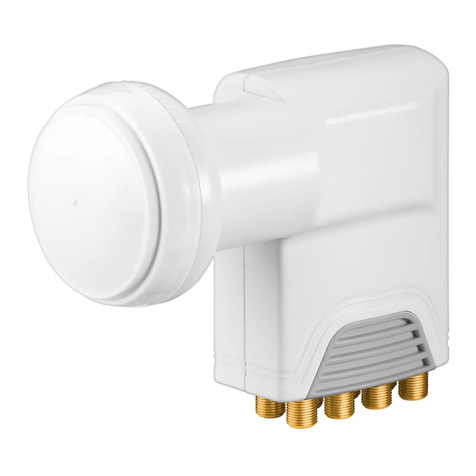Benchmark ADC16 User manual

Benchmark ADC16
Instruction Manual
16-Channel 24-bit 192-kHz
Audio Analog-to-Digital Converter

ADC16 Instruction Manual –Rev A Page 2
Contents
Overview 3
Features 5
Front Panel 6
AC Power Switch 7
Clock Settings 8
Clock Status Indication 9
Source for Digital Outputs 10
Optical Output Format 11
Meter Display 12
Meter Scale and Peak Hold 12
Rear Panel 13
Analog Line-Level Inputs 15
Input Level Trim-Pots 15
AES Digital Audio I/O 16
Coaxial Digital Audio Outputs 17
Optical Digital Audio Outputs 18
Clock Reference Input 19
Word Clock Reference Output 19
Slot for Optional Interface Cards 19
AC Power Entry Connector 19
Fuse Holder 19
Specifications 20
Audio Performance 20
Group Delay (Latency) 21
Balanced Analog Audio Inputs 22
WC/SC/AES Clock Reference Input 22
AES Clock Reference Input 22
Balanced AES/EBU Digital Outputs 23
Coaxial Digital Outputs 23
Multi-Format Optical Digital Outputs 23
DAW Card Slot 23
Controls 24
Status Indicators 24
Meters 24
Power Requirements 24
Fuses 24
Dimensions 25
Weight 25
ADAT S/MUX Tutorial 26
Proper S/MUX Identification 26
ADAT S/MUX2Flag 26
No S/MUX4Flag 26
S/MUX Must be Decoded Before Digital
Processing 26
S/MUX Sample Rates Must Match 27
S/MUX Must Not be Used for SRC 27
UltraLockDDS™ … What Is It? 29
Regulatory Compliance 32
CE Certificate of Conformity 32
RoHS Compliance 33
Warranty Information 33
1 Year Warranty 33
Extended 5 Year Warranty - US and
Canada 33
Extended 2 Year International Warranty 34
Warranty Repair Procedure 34
Contact Information 35

ADC16 Instruction Manual –Rev A Page 3
Overview
The ADC16 is a reference-quality, 16-channel,
192-kHz, 24-bit, analog-to-digital audio
converter.
The ADC16 utilizes Benchmark's
UltraLockDDS™ clock system with multi-
function clock input and word clock output.
UltraLockDDS™ is a proprietary clock-sync
system that is immune to jitter.
UltraLockDDS™ is phase-accurate, even
across multiple ADC16 units.
The ADC16 has a wide variety of interfaces,
including AES/EBU, coaxial, ADAT, Toslink,
and more via an optional interface card. The
optical output supports AES or ADAT formats
at resolutions up to 192/24. In ADAT mode,
high sample rates are supported using
S/MUX2and S/MUX4. The optional interface
card will enable direct connectivity to a
computer and other devices.
The signal-level meters on the ADC16 are
dual-range, 9-segment LEDs. The meters can
easily be switched to display a range of 48 dB
or 20 dB. The meters also have a peak-hold
function. The meters are single-sample
accurate for precise digital signal metering.
The ADC16 is designed for maximum
transparency. The ADC16 is well suited for
the most demanding applications in recording
and film studios. The internal power supply
supports all international voltages and has
generous margins for over and under voltage
conditions.
The ADC16 achieves outstanding performance
over a wide range of input levels. Each
channel has a 10-turn gain calibration
trimmer with a gain range of 23 dB. The gain
calibration controls may be used to calibrate
the ADC16 to precise studio reference levels.
The ADC16 has a BNC Word Clock output that
follows the sample rate indicated on the
front-panel display. Word Clock output is
active in all modes of operation.
A multi-format clock-input automatically
recognizes AES/EBU, SPDIF, Word Clock, or
Super Clock signals. This clock input is used
to synchronize the digital outputs. If desired,
the digital outputs may be clocked to the
ADC16's high-precision internal clock. The
ADC16 will automatically revert to the internal
clock source when the external clock is lost.
The ADC16 has four clock modes: 'DAW'
(optional interface card), 'AES' (DB-25
AES/EBU input), 'WC' (BNC), and 'INT'
(internal). All modes support sample rates
between 28 kHz and 200 kHz.
The 'DAW', 'AES', and 'WC' modes allow the
ADC16 to lock to an external clock reference.
In these modes, the ADC16 will follow
changes in sample rate. In 'WC' mode, the
ADC16 will also follow changes in the type of
reference signal (AES, SPDIF, word clock, or
super clock).
When the 'INT' mode is chosen, the ADC16 is
acting as clock master, operating at the
selected sample rate. In the 'INT' mode, any
signal at the clock-reference input will be
ignored. If 'INT' mode is used, all devices
connected to the ADC16 digital outputs will
need to be configured to lock to the ADC16.
Also, if the 'INT' mode is used, all other digital
sources (A/D converters, etc) connected to
the recording system must be synced to the
ADC16's clock. The 'WC' output and any of
the digital audio outputs on the back of the
ADC16 may be used as clock references to
feed connected devices.
The Benchmark UltraLockDDS™ clock-system
is highly immune to jitter. When synced to
the DAW, AES/EBU, WC, and super clock
interfaces, the A/D conversion-clock is
optimally conditioned using a technology
called Direct Digital Synthesis (DDS). The
UltraLockDDS™ system utilizes a
temperature-compensated crystal oscillator to
achieve an accurate center frequency
(important when the ADC16 is operating as a
master clock). The DDS system operates at

ADC16 Instruction Manual –Rev A Page 4
500 MHz and includes digital filters to remove
jitter from the reference clock input. The
Benchmark UltraLockDDS™ clock-system
outperforms two-stage PLL designs while
providing the frequency agility to handle the
special sample rates that are often required
for video transfers to and from film.
The Benchmark UltraLockDDS™ system
delivers consistent performance under all
operating conditions. Users should not
hesitate to lock the ADC16 to other clock
sources. The UltraLockDDS™ will remove
jitter from the external clock reference, and
supply a clean clock to the internal A/D
converters.
The predecessor of UltraLockDDS™ is
UltraLock™, Benchmark's pioneering jitter-
elimination technology. UltraLockDDS™
meets or exceeds the performance of
Benchmark's UltraLock™ system, but does
not use asynchronous sample rate conversion
(ASRC). The elimination of the ASRC
processing reduces system latency and
provides the most direct path from the A/D to
the digital interface.
The ADC16 is designed to perform gracefully
in the presence of errors and interruptions at
the clock reference input. The ADC16 will
even lock to an AES/EBU signal that has its
sample-rate bit status set incorrectly since
the sample rate is determined by measuring
the incoming signal. Lack of sample-rate
status bits or incorrectly set status bits will
not cause loss of audio.
The ADC16 is phase-accurate between
channels and between other ADC16 boxes
when locked to AES/EBU or word clock
reference signals. The word clock output from
one ADC16 may be connected to the clock
input on another ADC16 to expand the
number of phase-accurate conversion
channels.

ADC16 Instruction Manual –Rev A Page 5
Features
Sixteen (16) channels of 24-bit analog-to-digital audio conversion
9-segment dual-range digital LED meters with 'peak-hold' functionality
Multifunction clock input with auto-recognition of AES, SPDIF, Word Clock, or Super Clock
Capable of synchronizing to a master clock, other digital sources, and/or computer
Benchmark's phase-accurate jitter-immune UltraLockDDS™ technology
High-precision, low-jitter master clock via a temperature-compensated crystal oscillator
Word Clock output
Balanced analog inputs via two DB-25 connectors (eight channels per DB-25) - Tascam
pinout
+6 dBu to +29 dBu input sensitivity range (at 0 dBFS)
10-turn gain-calibration controls (1 per channel) with a 23 dB gain range
'Press-and-hold' buttons to prevent catastrophic incidents
Sample-rate selector and indicator for digital outputs
Conversion at sample rates between 28 and 200 kHz
Five types of digital output (AES/EBU, Coaxial, Toslink, ADAT, and optional interface card)
All digital outputs can be sourced from internal A/D or from optional interface card (DAW)
Optical output supports AES/EBU, ADAT, ADAT S/MUX2, and ADAT S/MUX4output formats
THD+N = -104 dB, 0.00063% @ -3 dBFS input, SNR 121 dB A-weighted
Reliable and consistent performance under all operating conditions
Internal 90 - 264 VAC international power supply
Meets FCC Class B and CE emissions requirements
Tested to EN 6100-6-2 for RF immunity

ADC16 Instruction Manual –Rev A Page 6
Front Panel
AC Power Switch - page 7
Clock Source - page 8
Settings: Internal Clock, Lock to WC / SC, Lock to AES, Lock to DAW Card
Clock Sample Rate - page 8
Settings: 44.1, 48, 88.2, 96, 176.4 and 192 kHz
Clock Status Indication - page 9
Lock Status, Reference Sample Rate, Error Reporting
Source for Digital Outputs - page 10
Settings: Source = Internal A/D Converters, Source = DAW Card
Optical Output Format - page 11
Settings: AES Format, ADAT Format, ADAT S/MUX2, ADAT S/MUX4
Meter Display - page 12
16 Dual-Range 9-Segment LED Meters, Driven from A/D Digital Outputs
Meter Scale and Peak Hold - page 12
Settings: Scale Factor = 1 dB/step or 6 dB/step, Peak-Hold On/Off

ADC16 Instruction Manual –Rev A Page 7
AC Power Switch
DPDT (double-pole, double-throw) switch
disconnects both sides of the AC line. When
this switch is 'OFF', the ADC16 draws no
power. When this switch is turned 'ON', the
ADC16 will boot up and calibrate within 5
seconds.
User settings are automatically stored in
memory. These settings are automatically
recalled when power is restored.

ADC16 Instruction Manual –Rev A Page 8
Clock Settings
The 'CLOCK' control interface consists of a
'CLOCK SOURCE' button, a 'Sample Rate'
button. Each button has a corresponding LED
display.
The ADC16 can operate from its internal
clock, or it can lock to a variety of external
clock sources. Valid clock signals include
Word Clock, Super Clock, AES, SPDIF, and
the optional 'DAW' interface card.
Clock Source
'Clock Source' Button
The 'CLOCK SOURCE' button is a 'press-and-
hold' switch. This means that the user must
hold in the button for one second before the
clock source changes. The 'press-and-hold'
action prevents accidental changes.
'CLOCK SOURCE' LED Display
The 'CLOCK SOURCE' display indicates which
input is acting as a clock reference for the
ADC16. The indicators are as follows:
DAW –On = clock is locked to the
optional interface card
AES –On = clock is locked to the
AES/EBU input via DB-25
WC –On = clock is locked to the WC
input via BNC
INT –On = clock reference is the
ADC16's internal clock
Clock Sample Rate
The 'SAMPLE RATE' control interface consists
of a 'SAMPLE RATE' button and LED display.
The 'SAMPLE RATE' Button
The 'SAMPLE RATE' button sets the sample
rate when the ADC16 is in the 'INT' clock-
source mode. This button is only active when
the 'INT' LED is on.
To change the internal clock sample rate,
press and hold the 'SAMPLE RATE' button.
The 'SAMPLE RATE' button must be held for 1
second to change to the next rate. The
'press-and-hold' action prevents accidental
changes.
'SAMPLE RATE' LED Display
44.1kHz
48 kHz
88.2 kHz
96 kHz
176.4 kHz
192 kHz
The 'SAMPLE RATE' LED display always
indicates the sample rate at which the ADC16
is operating.

ADC16 Instruction Manual –Rev A Page 9
In any external clock mode, the ADC16 will
automatically follow the sample rate of the
external reference signal. The measured
sample rate of the external source will be
displayed on the LEDs.
If the reference signal is good, the ADC16 will
lock within 8 seconds. The ADC16
UltraLockDDS™ system is very tolerant of
poor quality clock reference signals.
Clock Status Indication
Clock Error - Not Locked
'Clock Source' LED flashing rapidly
If selected clock source is present, the
corresponding clock source LED will flash
rapidly while the system is acquiring lock.
Allow up to eight seconds for the system to
lock. Failure to lock within 8 seconds is an
indication that the clock signal is corrupt or
invalid. After eight seconds, the clock system
will revert to internal sync, and the 'INT' LED
will turn on. The LED corresponding to the
selected sync source will continue to flash
once per second (indicating the "no-
reference" error condition).
Action: Check cables, connect a valid clock
signal, switch to a different clock source, or
switch the ADC16 to internal clock. Sample
rate of external clock must fall within one of
the following ranges: 28 –50 kHz, 75-100
kHz, or 150 kHz-200 kHz
Clock Error - No Reference
'Clock Source' LED flashing once per
second, and "INT" LED ON
If no signal is present on the selected clock
input, the corresponding 'Clock Source' LED
will flash once per second, and the "INT' LED
will be on, indicating that the system has
reverted to internal sync.
Action: Check cables, connect a valid clock
signal, switch to a different clock source, or
switch the ADC16 to internal clock.
Clock Error - DAW Frequency
'Sample Rate' LEDs flashing once per
second
If the 'SAMPLE RATE' LED display is flashing,
this is an indication that the ADC16 and
optional DAW card are operating at different
frequencies. The DAW card is only functional
when the DAW sample rate matches that of
the ADC16.
Action: Change the sample rate of either the
DAW, the ADC16, or the external clock
reference. The ADC16 and DAW sample rates
must match.
Clock Error - DAW Clock Mode
'DAW' 'Clock Source' LED is flashing once
per second
If the DAW clock mode conflicts with the
ADC16 clock mode, the 'DAW' 'Clock Source'
LED will flash once per second. This can only
occur when the ADC16 is not using the DAW
as a clock source, or when the DAW card is
configured to lock to a source other than the
ADC16.
Action: Either change the ADC16 clock
source to 'DAW', or configure the DAW card
to use the ADC16 as a reference.

ADC16 Instruction Manual –Rev A Page 10
Source for Digital Outputs
The digital outputs can stream digital audio
data from either the ADC16's internal A/D
converters or from the source connected to
the optional 'DAW' interface card.
To select the source for a set of digital
outputs, press and hold the 'SOURCE' button
for that set of digital outputs ('AES OUT',
'SPDIF OUT', and 'OPTICAL OUT'). The
'SOURCE' button must be held for 1 second to
change. The 'press-and-hold' action prevents
accidental changes.
Routing A/D Conversion Directly
to Outputs
When 'A/D' is selected, the ADC16's internal
A/D converters are routed directly to the
digital outputs.
In any mode of operation, the A/D converter
outputs are also routed to the optional 'DAW'
card.
Using the ADC16 as a Digital DAW
Interface
The optional DAW card provides a bi-
directional 16-channel interface to an external
device such as a digital audio workstation
(DAW). The 16-channel return path from the
DAW can be routed to external D/A
converters using any of the digital audio
outputs on the ADC16. In such a system, it
is not necessary to purchase a DAW interface
for the D/A converters. The ADC16 provides
the interface between the DAW and the
external D/A converters.
Routing A/D outputs through a
DAW and Back to Digital Outputs
The optional 'DAW' card provides a bi-
directional 16-chanel interface between the
ADC16 and a DAW. Analog audio can be
converted in the ADC16, sent to the DAW,
mixed in the DAW and sent back out through
the ADC16 to external D/A converters.
Multiple mixes can be created for monitor
feeds or other uses.
Using the ADC16 with an Analog
Summing Bus
The bi-directional 'DAW' interface card can be
used to send up to 16 channels of audio to
external D/A converters feeding an analog
summing bus. The outputs of the summing
bus can be connected to the analog inputs on
the ADC16 (and sent back to the DAW).
Using the ADC16 to Interface a
DAW with Analog Effects
The bi-directional 'DAW' interface card can be
used to send up to 16 channels of audio to
external D/A converters feeding analog
effects. The analog outputs of the effects can
be connected to the analog inputs on the
ADC16 (and sent back to the DAW).

ADC16 Instruction Manual –Rev A Page 11
Optical Output Format
The optical output can provide either
AES/EBU or ADAT format. The AES/EBU
mode works with most S/PDIF optical inputs.
Press and hold the 'FORMAT' button to change
the optical output format. The 'press-and-
hold' action prevents accidental changes.
When ADAT is active, S/MUX is automatically
enabled at all 2X and 4X sample rates (88.2
kHz, 96 kHz, 176.4 kHz, and 192 kHz).

ADC16 Instruction Manual –Rev A Page 12
Meter Display
The ADC16 is equipped with a multi-function
9-segment LED meter. The 'SCALE' button
selects either a 6 dB step or 1 dB step scale
and controls the peak-hold function. Metering
is fully digital and post-conversion for
absolute accuracy. The units are dBFS (dB
relative to the maximum possible digital
signal).
Time constants are built into the meters so all
transient peaks can be observed easily. If a
transient peak has a duration as short as one
digital sample, an LED will be illuminated and
remain illuminated long enough to be
observed by the human eye.
A peak indication mimics the action of the
needle on a peak-reading analog meter, while
the remaining LEDs will follow the
instantaneous level of the audio.
The red 0 LED indicates that a full-scale
digital code has been reached and that digital
clipping has occurred. Full-scale events as
short as one digital sample will light the 0
LED. Short single-sample digital clipping
events are often audible, and all 0-dBFS
events should be avoided.
The ADC16 has a very large dynamic range.
It is wise to use some of this dynamic range
to provide more headroom as insurance
against clipping. Leave some extra headroom
between your highest anticipated peak and
the red 0 dBFS LED.
Meter Scale and Peak Hold
The 'SCALE' button selects the scale and
peak-hold mode of the 9-segment LED Meter
Display.
Meter Scale and Peak Hold
Function Selection
Press the 'SCALE' button momentarily to
enable or disable the Peak Hold function.
Press and hold the 'SCALE' button to switch
the scale between 1 dB steps and 6 dB steps.

ADC16 Instruction Manual –Rev A Page 13
Rear Panel
Analog Line-Level Inputs - page 15
Tascam Analog DB-25 Standard Pinout - 2 Connectors - 16 Channels In
Input Level Trim-Pots - page 15
One 10-Turn Trimmer per Channel, 23 dB Adjustment Range, Preset for +4 dBu @ -20 dBFS
AES Digital Audio I/O - page 16
Tascam AES/EBU DB-25 Standard Pinout - 2 Connectors - 16 Channels Out - 2 Channels In
Coaxial Digital Audio Outputs page 17
AES Professional Format 1Vpp Coaxial Outputs - 16 Channels Out
Optical Digital Audio Outputs - page 18
8 Optical Output Connectors - Supporting AES, ADAT, S/MUX2, and S/Mux4
Clock Reference Input - page 19
75-Ω BNC Input - Accepts Word Clock, Super Clock, and AES Input - Auto Recognizing
Word Clock Reference Output - page 19
75-Ω BNC Output - 2.5 Vpp into 75-Ω Load, DC Coupled

ADC16 Instruction Manual –Rev A Page 14
Slot for Optional Interface Cards - page 19
See http://www.BenchmarkMedia.com/ADC16/optional-interface-card
AC Power Entry Connector - page 19
IEC Power Connector
Fuse Holder - page 19
Requires two 0.5 Amp 5 x 20 mm 250 V Slo-Blo®Type fuses

ADC16 Instruction Manual –Rev A Page 15
Analog Line-Level Inputs
The balanced "ANALOG IN" line-level inputs
follow the Tascam Analog DB-25 standard.
Cables are available from many sources.
The analog inputs are factory calibrated to an
input sensitivity of +4 dBu @ -20 dBFS. Rear-
panel trim pots ( ) allow adjustment over a
23-db range. At minimum gain, the
sensitivity is +9 dBu at -20 dBFS. At
maximum gain, the sensitivity is -14 dBu at -
20 dBFS. Unbalanced -10 dBv inputs are
easily accommodated within this range.
The input impedance is 200k Ohms balanced,
and 100k Ohms unbalanced.
Each analog input is equipped with an RF
filter network. The ADC16 exhibits no
measurable change in performance when
subjected to EN 61000-6-2 RF immunity
tests.
'ANALOG IN' DB-25 Pinout
The 'ANALOG IN' DB-25 pinout follows the
Tascam Analog DB-25 standard:
H = "+" (or hot), C = "-" (or cold), G = GND
Unbalanced Source Adaptation
1. Connect "+" or hot (tip on ¼ phone plug,
center pin on RCA plug).
2. Connect both the ground conductor AND
the"-" conductor to the connector's
ground (sleeve on ¼" phone plug, or case
on RCA plug).
NOTE: When connecting an unbalanced
source to the balanced analog input, it's best
to use balanced wiring ("+", "-", "shield") and
to tie the "-"and "shield" at the unbalanced
connector (source).
Input Level Trim-Pots
Each channel on the ADC16 is equipped with
10-turn "INPUT LEVEL" trim-pots. These trim
pots are located on the back panel near the
optical outputs.
The "INPUT LEVEL" trim-pots have a range of
approximately 23 dB. At their minimum
setting, the ADC16 will clip upon receiving a
+29 dBu analog input signal. At their
maximum setting, the ADC16 will clip upon
receiving a +6 dBu analog input signal.
The "INPUT LEVEL" trim-pots are factory-set
to clip at +24 dBu.

ADC16 Instruction Manual –Rev A Page 16
AES Digital Audio I/O
The balanced 'AES I/O' digital I/O connectors
follow the Tascam AES/EBU DB-25 standard.
Cables are available from many sources.
These 110-Ω 'AES I/O' connections include
DC-isolation, transformer-coupling, current-
limiting, and diode-protection. Outputs are
designed to drive standard 4 Vpp AES signals
into a 110-Ω load. 110-Ω digital cables are
required when connecting these signals to
other devices. Analog audio cables may
cause data transmission errors, and should
not be used to transmit digital audio.
Data Format = AES/EBU professional
Word Length = 24 bits
Sample Rate = 28 to 50 kHz, 75 to
100 kHz, and 150 kHz to 200 kHz
Clock Source = Internal or External
Data Source = A/D or DAW
The digital audio data at the ADC16's digital
outputs can come from one of two sources:
the ADC16's A/D converters ('A/D') or the
optional interface card ('DAW').
The user can select digital output sources via
the 'SOURCE' buttons on the front panel.
Each set of outputs ( 'AES I/O', 'S/PDIF', and
'Optical') has a 'SOURCE' selection button.
These may be used in any combination.
When DAW is selected as the source, the user
can assign any tracks or sub-mixes of tracks
to the AES outputs.
'AES I/O' DB-25 Pinout
The 'AES I/O' DB-25 pinout follows the
Tascam AES/EBU DB-25 standard:
H = "+" (or hot), C = "-" (or cold), G = GND
The Tascam AES/EBU DB-25 standard
provides four 2-channel inputs and four 2-
channel outputs for a total of 8 channels in
and 8 channels out (on each DB-25
connector). For example, 'Digital Out' '1'
carries channels 1 and 2, and 'Digital Out' '2'
carries channels 3 and 4.
The ADC16 uses all 4 of the digital outputs on
each DB-25 connector (for a total of 16 audio
channels on 8 digital outputs).
The ADC16 only uses one of the 8 available
digital inputs. Digital input 1 on the top DB-
25 connector (audio channels 1 and 2) can be
used as a clock reference input. The ADC16
can lock to an AES digital audio signal on this
input when 'Clock Source' is set to 'AES'.
All digital inputs (including the unused
inputs), are terminated with 110 Ω. 'Digital
In' '2', '3', and '4' are unused on the top DB-
25 connector. 'Digital In' '1', '2', '3', and '4'
are unused on the bottom DB15 connector.

ADC16 Instruction Manual –Rev A Page 17
Coaxial Digital Audio Outputs
The ADC16 features eight coaxial digital
outputs. There is one RCA coaxial connector
for each pair of digital-audio output channels.
The coaxial outputs are designed to operate
within AES3-id and SMPTE 276M standards,
and drive 1Vpp into 75-Ω. 75-Ω coaxial
cables are required when connecting these
outputs to other devices. Data transmission
errors may occur if the wrong cables are
used.
The coaxial outputs on the ADC16 are DC-
isolated, transformer-coupled, current-
limited, and diode-protected. They
incorporate filtering to minimize RF
interference and susceptibility.
Data Format = AES/EBU professional
Word Length = 24 bits
Sample Rate = 28 to 50 kHz, 75 to
100 kHz, and 150 kHz to 200 kHz
Clock Source = Internal or External
Data Source = A/D or DAW
The digital audio data at the ADC16's digital
outputs can come from one of two sources:
the ADC16's A/D converters ('A/D') or the
optional interface card ('DAW')
The user can select digital output sources via
the 'SOURCE' buttons on the front panel.
Each set of outputs ( 'AES I/O', 'S/PDIF', and
'Optical') has a 'SOURCE' selection button.
These may be used in any combination.
When 'DAW' is selected as the source, the
user can assign any tracks or sub-mixes of
tracks to the coaxial outputs.

ADC16 Instruction Manual –Rev A Page 18
Optical Digital Audio Outputs
The ADC16 features eight optical digital
outputs. These outputs can be operated in
four different modes: 'S/PDIF', 'ADAT', 'ADAT
S/MUX2', and 'ADAT S/MUX4'. The 'FORMAT'
button on the front panel toggles between
'S/PDIF' and 'ADAT' formats. If any ADAT
mode is selected, S/MUX2, or S/MUX4will be
enabled automatically depending upon the
system sample rate.
In 'S/PDIF' mode, each optical connector
carries two audio channels. Data format is
AES professional. The optical transmitters on
the ADC16 support a maximum sample rate
of 200 kHz in 'S/PDIF' mode . However, most
optical inputs do not support S/PDIF or AES
formats at high sample rates. Check the
specifications on connected equipment before
relying on high sample-rate optical
connections.
In 'ADAT' mode, each optical carries eight
channels of digital audio. In this mode, two
optical connectors are required to carry all 16
channels produced by the ADC16. The
remaining 6 optical connectors provide two
additional sets of outputs. 'ADAT' mode is
only available at sample rates between 28
and 50 kHz. If a higher sample rate is
selected, 'S/MUX2' or 'S/MUX4' is
automatically enabled.
ADAT 'S/MUX2' is available at sample rates
between 75 and 100 kHz. In this mode, each
optical output carries four channels of audio.
Four connectors are required for 16 channels
of audio. The 8 optical connectors on the
ADC16 carry two identical sets of data when
operating in ADAT 'S/MUX2'.
ADAT 'S/MUX4' is available at sample rates
between 150 and 200 kHz. In this mode,
each optical output carries two channels of
digital audio. All 8 optical connectors are
required, to carry 16-channels of audio.
The optical outputs use what is often called a
TOSLINK, Type FO5, or 5 mm optical
connector. The ADC16 uses a special high-
bandwidth version that supports AES/EBU
digital audio at sample rates up to 192 kHz.
Please note that many optical inputs cannot
support AES/EBU or SPDIF digital audio at
sample rates above 48 kHz. Some others are
limited to 96 kHz. A few products (such as the
Benchmark DAC1) support 192 kHz optical
inputs. Please note that high-bandwidth
optical transmitters and receivers are not
required for ADAT, ADAT S/MUX2, or even
ADAT S/MUX4.
AES/EBU 'S/PDIF' Optical Mode
Data Format = AES/EBU professional
Word Length = 24 bits
Sample Rates = 28 - 50 kHz, 75 - 100
kHz, and 150 - 200 kHz
Clock Source = Internal or External
Data Source = A/D or DAW
ADAT Optical Output Mode
Data Format = ADAT
Word Length = 24 bits
Sample Rates = 28 to 50 kHz
Clock Source = Internal or External
Data Source = A/D or DAW
ADAT S/MUX2Optical Output
Mode
Data Format = ADAT
Word Length = 24 bits
Sample Rate = 75 to 100 kHz
Clock Source = Internal or External
Data Source = A/D or DAW
ADAT S/MUX4Optical Output
Mode
Data Format = ADAT
Word Length = 24 bits
Sample Rate = 150 to 200 kHz
Clock Source = Internal or External
Data Source = A/D or DAW

ADC16 Instruction Manual –Rev A Page 19
Clock Reference Input
The Clock Reference Input uses a BNC
connector and is terminated with 75 Ohms.
This input is DC isolated and includes
overvoltage protection. This input auto-
detects AES/EBU, SPDIF, Word Clock, or 256X
Super Clock signals. When 'WC' mode is
active the ADC16 will lock to this external
clock input, and automatically follow changes
in sample-rate.
Benchmark's UltraLockDDS™ circuitry isolates
the conversion clock from any jitter present
on the clock reference. 'WC' mode will not
degrade the conversion quality of the ADC16,
even when very high levels of jitter are
present on the clock reference.
Word Clock Reference Output
The Word Clock output provides a clock signal
which can be used to synchronize
downstream components.
When the ADC16 is running in 'INT' mode
(internal clock mode), the clock frequency at
this output has an initial accuracy of +/- 5
PPM with a +/- 1PPM/yr aging characteristic.
The INT mode is suitable as a studio master
clock.
Slot for Optional Interface Cards
An interface card can be installed in the
ADC16. The card is installed in the slot to the
left of the AC power input. This slot provides
a bi-directional 16-channel interface to
external devices such as a digital audio
workstation (DAW).
For more information, go to
http://www.BenchmarkMedia.com/ADC16/opt
ional-interface-card
AC Power Entry Connector
The AC power input uses a standard IEC type
connector. Within the USA and Canada, the
ADC16 ships with a power cord. In other
locations, a location-specific IEC style power
cord may be purchased from a local source
(including a local Benchmark dealer).
Fuse Holder
The fuse holder is built into a drawer next to
the IEC power connector. The drawer
requires (two 5 x 20 mm 250 V Slo-Blo®
Type) fuses. The fuse rating (for all voltage
settings is 0.50 Amps).
Caution: Always install the correct fuses.
The mains power input has a very wide
operating range. The ADC16 power supply
can operate over an AC frequency range of 47
to 440 Hz, within a voltage range of 90 to 264
VAC. It can also operate from DC voltages
between 127 and 300 VDC. There are no
settings to change.

ADC16 Instruction Manual Page 20
Specifications
Audio Performance
Fs = 44.1 to 192 kHz, 20 to 20 kHz BW, 1 kHz test tone, 0 dBFS = +24 dBu (unless noted)
SNR –A-Weighted, 0 dBFS = +16 to +29 dBu
121 dB
SNR –Unweighted, 0 dBFS = +16 to +29 dBu
119 dB
SNR –A-Weighted at max gain, 0 dBFS = -10 dBv
117 dB
THD+N, 1 kHz at –1 dBFS
-102 dBFS, -101 dB, 0.00089%
THD+N, 1 kHz at –3 dBFS
-107 dBFS, -104 dB, 0.00063%
THD+N, 20 to 20 kHz test tone at –3 dBFS
-105 dBFS, -102 dB, 0.00079%
Frequency Response at Fs=192 kHz
-3 dB, +0 dB, 2 Hz to 94 kHz
+/- 0.02 dB, 20 Hz to 20 kHz
-0.06 dB at 10 Hz
-0.01 dB at 20 Hz
+0.02 dB at 20 kHz
-0.35 dB at 88 kHz
-3 dB at 94.6 kHz
-117 dB at 108 kHz
Frequency Response at Fs=96 kHz
-3 dB, +0 dB,1 Hz to 47 kHz
+/- 0.01 dB, 20 Hz to 20 kHz
-0.06 dB at 10 Hz
-0.01 dB at 20 Hz
+0.02 dB at 20 kHz
-0.10 dB at 44 kHz
-3 dB at 47.3 kHz
-115 dB at 54 kHz
Frequency Response at Fs=48 kHz
-3 dB, +0 dB, 1 Hz to 23.6 kHz
+/- 0.01 dB, 20 Hz to 20 kHz
-0.06 dB at 10 Hz
-0.01 dB at 20 Hz
+0.02 dB at 20 kHz
-0.10 dB at 22 kHz
-3 dB at 23.6 kHz,
-110 dB at 27 kHz
Passband Ripple
+/- 0.001 dB at 44.1 and 48 kHz
+/- 0.003 dB at 88.2 and 96 kHz
+/- 0.007 dB at 176.4 and 192 kHz
Crosstalk
-96 dB at 20 kHz
-120 dB at 1 kHz
< -135 dB at 20 Hz
Jitter Tolerance (With no Measurable Change in THD+N
Performance)
>12.75 UI sine, 100 Hz to 10 kHz
> 3.5 UI sine at 20 kHz
> 1.2 UI sine at 40 kHz
> 0.4 UI sine at 80 kHz
> 0.29 UI sine at 90 kHz
> 0.25 UI sine above 160 kHz
Maximum Amplitude of Jitter-Induced Sidebands
< -116 dB (10 kHz 0 dBFS test tone,
12.75 UI sinusoidal jitter at 1 kHz)
Maximum Amplitude of Spurious Tones with 0 dBFS test
signal
-130 dBFS
Maximum Amplitude of Idle Tones
-130 dBFS
Table of contents
Other Benchmark Media Converter manuals

Benchmark
Benchmark DAC1 USB User manual
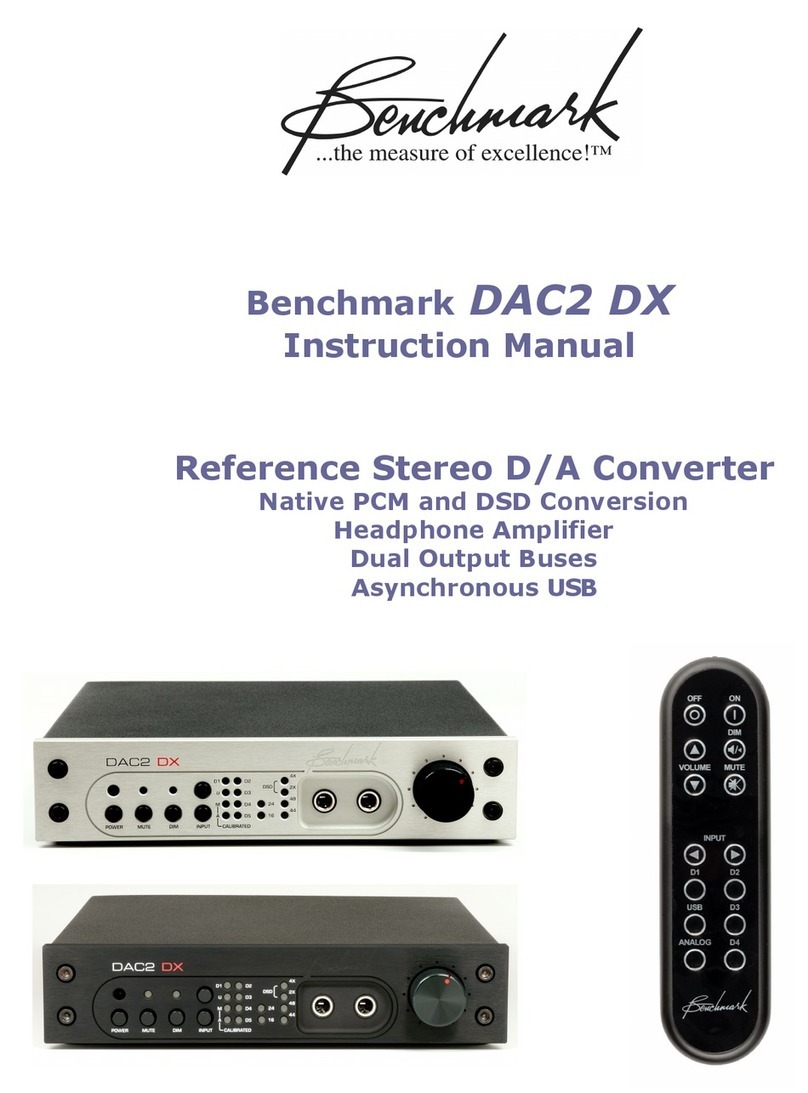
Benchmark
Benchmark DAC2 DX User manual

Benchmark
Benchmark DAC3 HGC Quick start guide
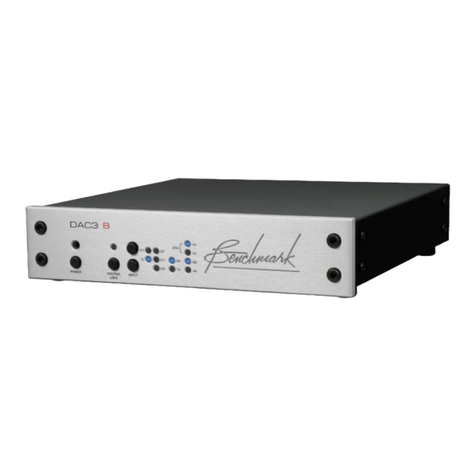
Benchmark
Benchmark DAC3 B User manual

Benchmark
Benchmark DAC2 DX User manual
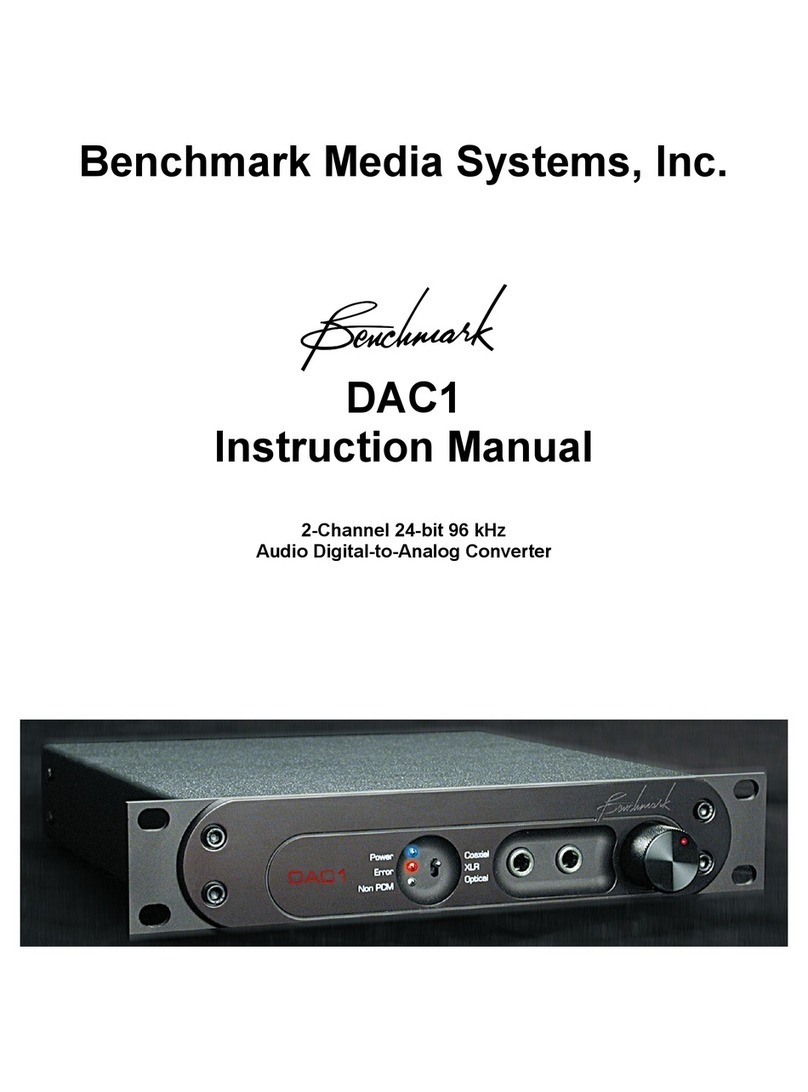
Benchmark
Benchmark DAC1 HDR User manual
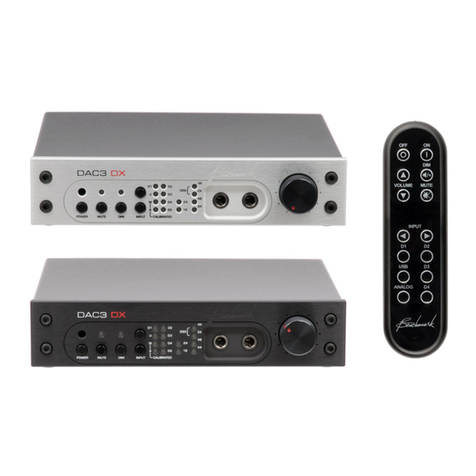
Benchmark
Benchmark DAC3 DX User manual
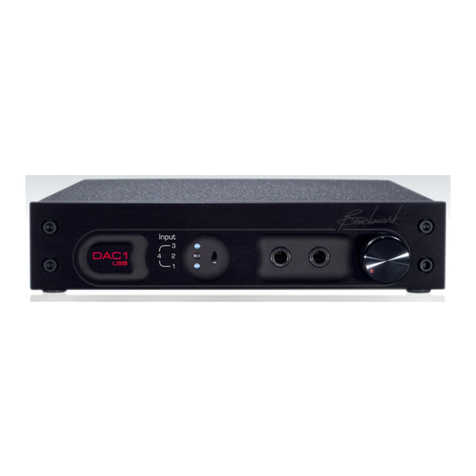
Benchmark
Benchmark DAC1 HDR User manual
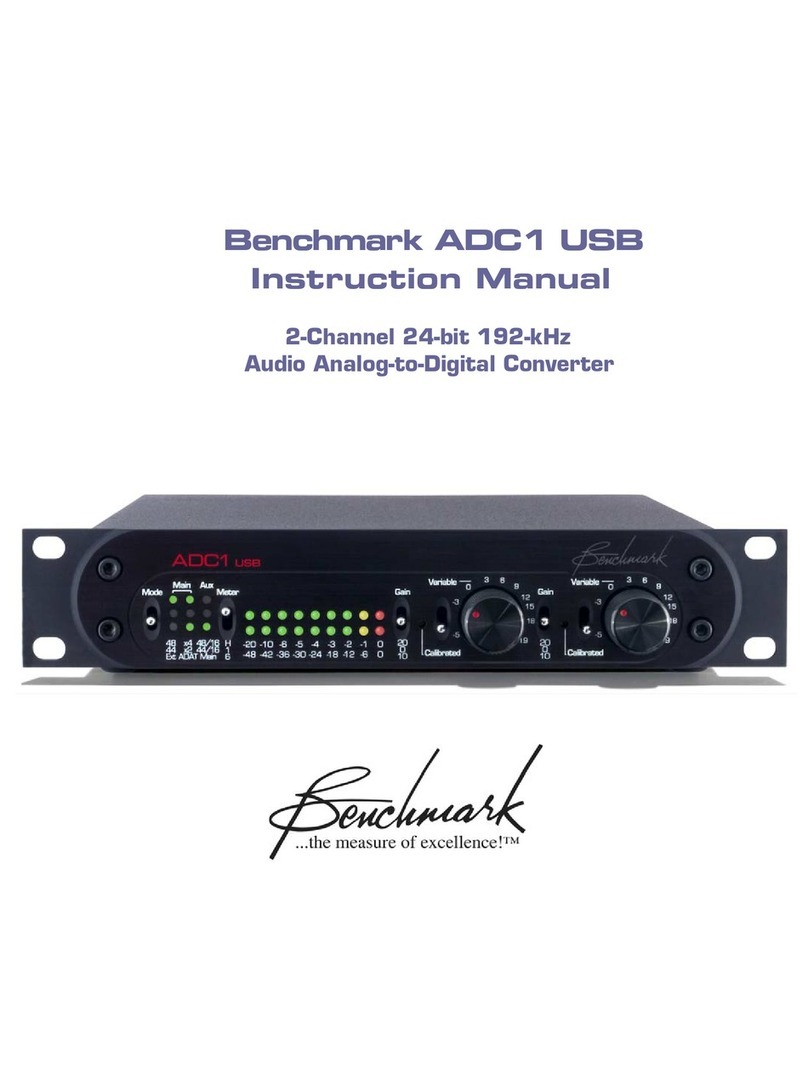
Benchmark
Benchmark ADC1 USB User manual
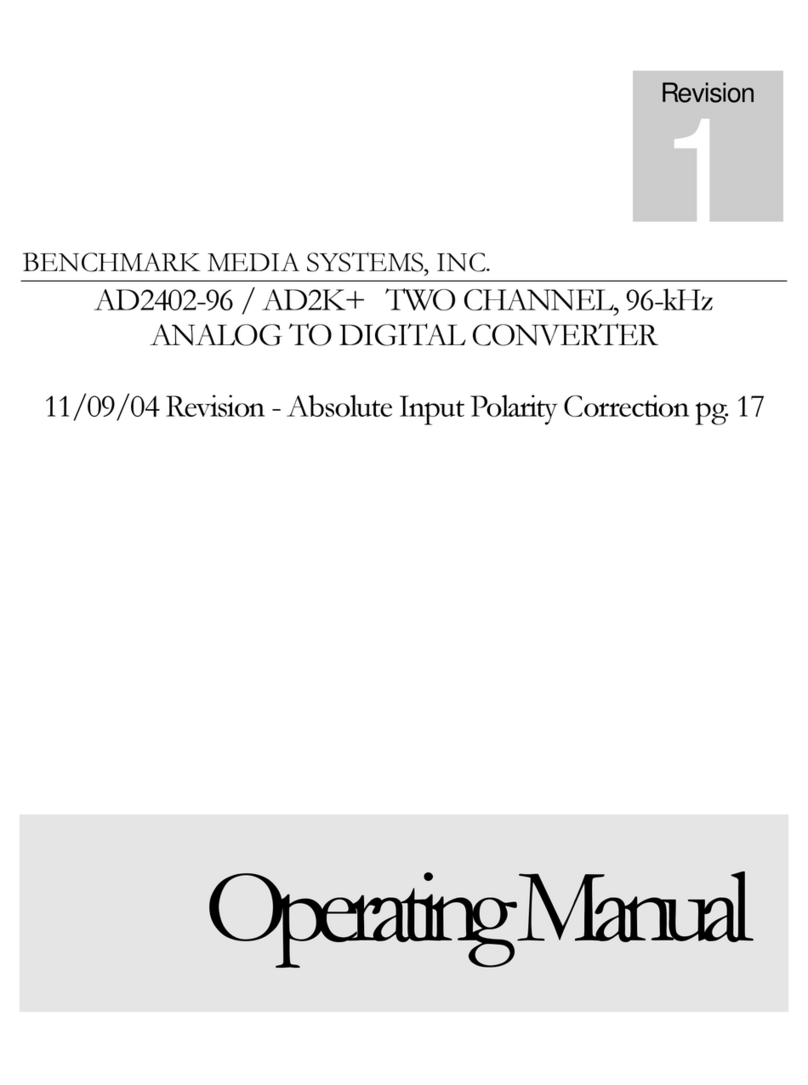
Benchmark
Benchmark AD2402-96 User manual
Popular Media Converter manuals by other brands
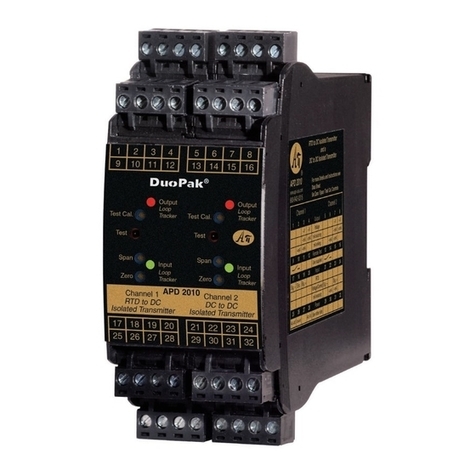
Absolute Process Instruments
Absolute Process Instruments DuoPak APD 2010 manual

Transition Networks
Transition Networks NANOMETER E-100BTX-SX-01 user guide
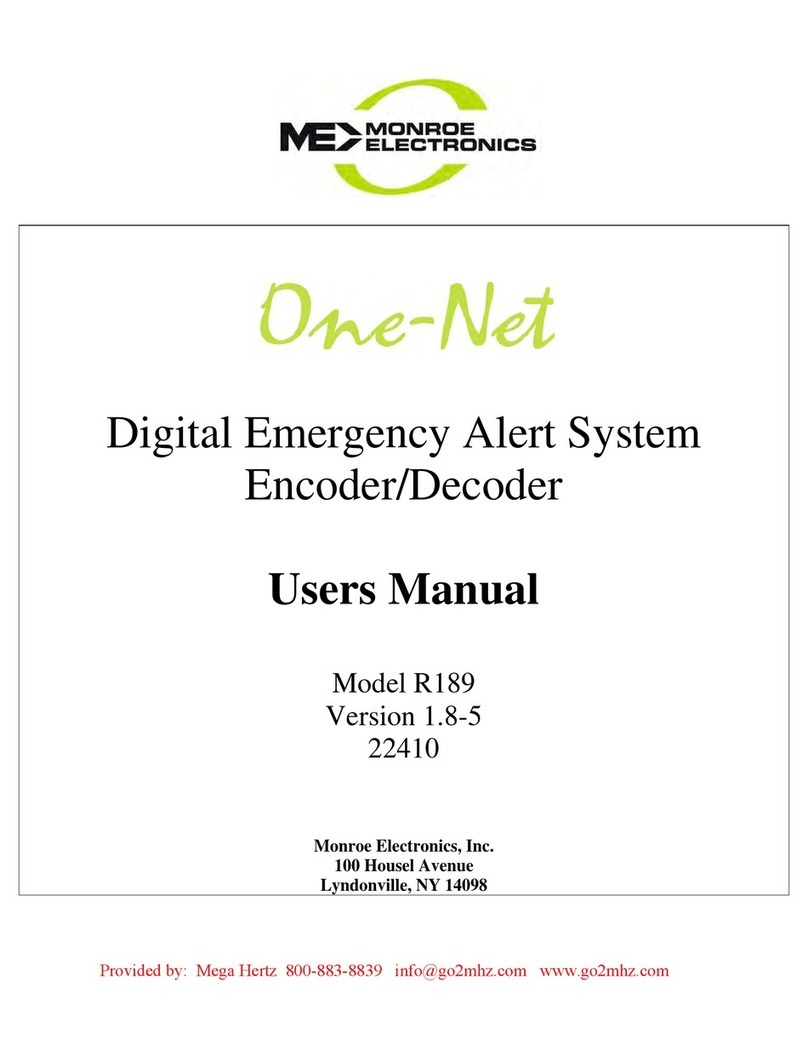
Me
Me R189 user manual
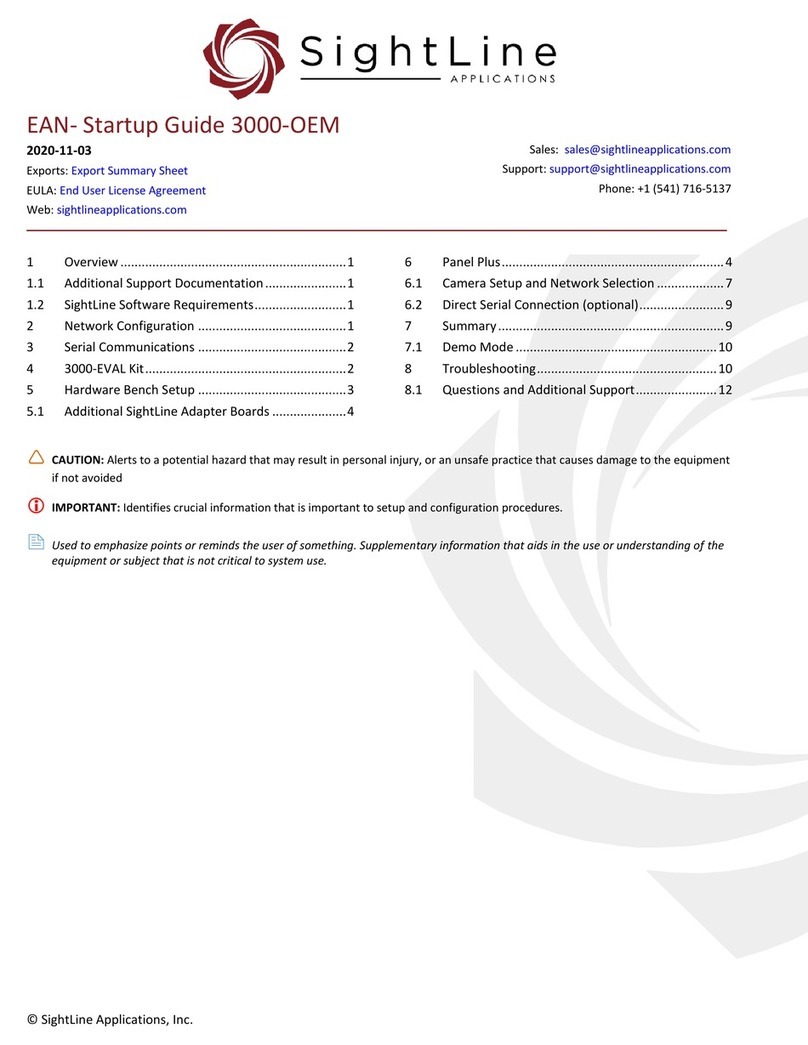
SightLine
SightLine 3000-OEM Startup guide

Vetra
Vetra SmartWye USB-311 User instructions
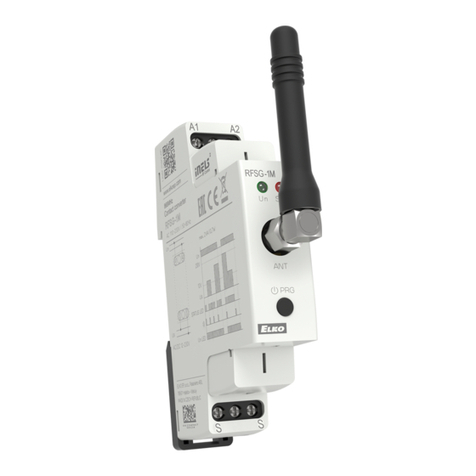
Elko
Elko inels RFSG-1M quick start guide


